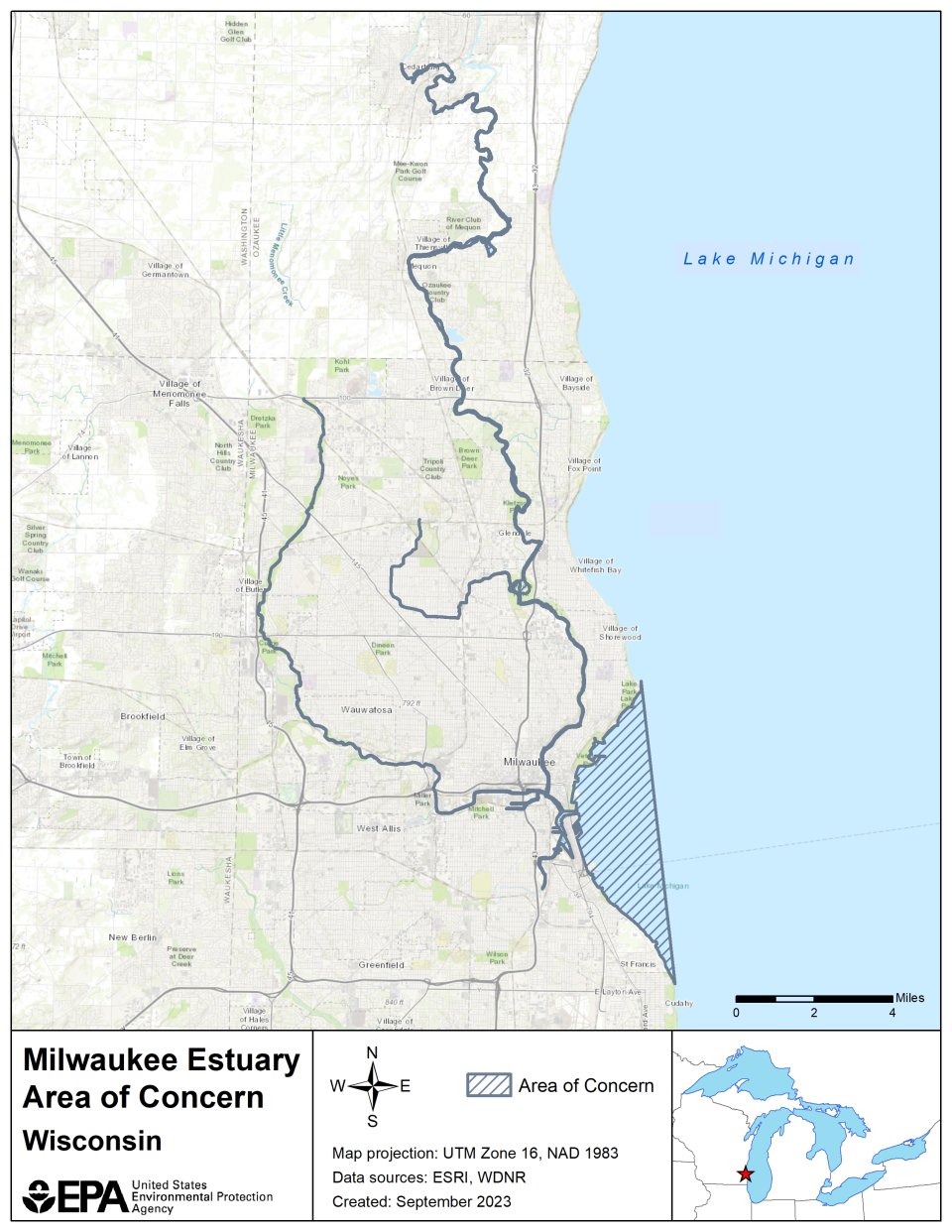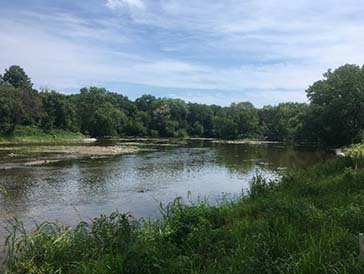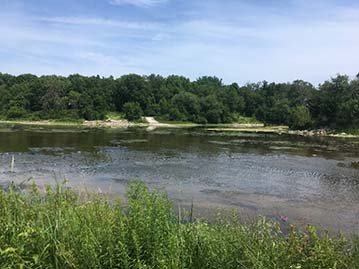Milwaukee Estuary AOC
Kate Stephens
(Stephens.Katherine@epa.gov)
312-353-0201
The Milwaukee Estuary is one of the 31 U.S.-based Areas of Concern across the Great Lakes created under the 1987 Great Lakes Water Quality Agreement.
Historic activities throughout this predominantly industrial and urbanized watershed have resulted in pollution accumulation in the AOC. Pollution sources associated with land use from the drainage basin affect its water quality. The pollution comes from both point and nonpoint sources including: historic industrial discharges, wastewater treatment plants, combined sewer overflows, and agricultural and urban runoff. The primary contaminants in the Milwaukee Estuary AOC are Polychlorinated Biphenyls, Polycyclic Aromatic Hydrocarbons, and heavy metals.
Cleanup in this area is important to the Milwaukee economy and the communities that surround the estuary. Cleanup and restoration are vital to enhance recreational use of the estuary, thereby boosting tourism and community engagement.
Beneficial Use Impairments
An interim success of remediation (cleanup) and restoration work is removing Beneficial Use Impairments. BUIs are designations given by the International Joint Commission, representing different types of significant environmental degradation. As cleanup work is completed, and monitoring demonstrates sufficient environmental health improvements, BUIs can be removed. Of the 14 potential BUIs, 11 were assigned to the Milwaukee Estuary AOC. Once all BUIs are removed, the process of delisting the AOC can begin.
- Restrictions on Fish and Wildlife Consumption.
- Eutrophication or Undesirable Algae.
- Degradation of Fish and Wildlife Populations.
- Beach Closings.
- Fish Tumors or Other Deformities.
- Degradation of Aesthetics (pdf) - Removed September 2021
- Bird or Animal Deformities or Reproduction Problems.
- Degradation of Benthos.
- Degradation of Phytoplankton and Zooplankton Populations.
- Restriction on Dredging Activities.
- Loss of Fish and Wildlife Habitat.
- Beneficial Use Impairments for the Great Lakes AOCs
- Information on the CAC: Community Advisory Committee
- Milwaukee Estuary AOC Partners & Projects: Waterway Restoration Partnership
Remediation and Restoration Work
Over the past 5 years, GLRI has provided over $30 million in funding for 11 habitat restoration projects across the AOC targeting the Loss of Fish and Wildlife Habitat BUI. These projects have removed dams, flow barriers, and concrete to help increase the in-water habitat available to fish and wildlife populations and increase fish passage in the AOC. Removing concrete created a more naturalized pool and riffle system that gives fish areas to rest as they migrate north. The projects also enhanced fish spawning and nursery habitat. These projects will also transform the Burnham Canal, a historic shipping canal that is no longer navigable, into wetland habitat. Wetlands in the canal would improve water quality and greatly enhance fish and wildlife habitat, especially for northern pike that prefer to spawn in vegetated wetland areas in the spring. Increased fish habitat and fish passage in the AOC will lead to new fishing spots opening up for anglers.
Two sediment remediation projects have been completed at the Milwaukee Estuary AOC under the Great Lakes Legacy Act. Over 330,000 cubic yards of sediment contaminated with PCBs, PAHs, and hazardous non-aqueous phase liquids was remediated at the Kinnickinnic River and Lincoln Park at a total cost of $65.6 million.
Another GLLA sediment remediation project in the AOC is currently in the Feasibility Study phase. Next steps would include Pre-Design Investigations and Remedial Design. This project has the potential to remediate up to 1.4 million cubic yards of sediment contaminated with PCBs, PAHs, heavy metals, and NAPL across the Greater Milwaukee Estuary, including at the Milwaukee, Menomonee, and Kinnickinnic Rivers as well as the inner and outer harbors. State and local partners working with the EPA to implement this project include Wisconsin Department of Natural Resources, the City of Milwaukee, Milwaukee County, Milwaukee Metropolitan Sewerage District, and We Energies.
Three projects will address the Beach Closings BUI. The South Shore Beach Rehabilitation project will result in less human health risks and more days without beach advisories and closures compared to the current swim area which is impacted by contaminated runoff and poor water circulation. The South Shore Beach Rehabilitation project is expected to begin in 2024.
Other upcoming projects that are expected to take place to address the Degradation of Fish and Wildlife Populations BUI in the next 3-4 years will help restore and enhance floodplain forest, upland forest, shrubland, wetland, and aquatic habitat for a diverse assemblage of fish and wildlife. A corridor of the Little Menomonee River will be restored to further improve aquatic habitat for fish and wildlife populations. The Havenwoods State Forest rehabilitation project will restore with native plants and habitats on 237 acres of urban land located on the far north side of the City of Milwaukee. Seven parks along the Milwaukee River Greenway will be restored and enhanced to support a diversity of species. These projects will also further promote fish passage in the AOC.
- Documents on Restoring Milwaukee Estuary AOC
- Remedial Action Plan Update for the Milwaukee Estuary Area of Concern
- Remediation and Restoration Projects for Milwaukee Estuary AOC
Restoration Project Highlight: Estabrook Dam Fish Passage
The Milwaukee Metropolitan Sewerage District in partnership with WDNR received GLRI and Fund for Lake Michigan money to remove the Estabrook Dam. The dam was initially constructed in the 1930s for recreational purposes but was removed to allow fish access to upstream spawning and nursery habitats, increasing their availability to the lake and estuary. By removing the dam, a critical link to habitat in the upstream portions of Milwaukee River watershed was re-established.
This project, along with another GLRI/FFLM-funded AOC fish passage endeavor, opened and connected 25 miles of the Milwaukee River, 29 miles of tributary stream, and over 2,400 acres of wetland spawning and nursery habitats. The removal of the Estabrook Dam is an important aspect in connecting habitats within the Milwaukee River thereby protecting the aquatic species and other wildlife that inhabit it.
Video on the Estabrook Dam Fish Passage Project
Targeted BUIs:
- Degradation of Fish and Wildlife Populations
- Loss of Fish and Wildlife Habitat
Remediation Project Highlight: Lincoln Creek and Milwaukee River Channel Legacy Act Cleanup
The Wisconsin Department of Natural Resources, the Milwaukee County Parks, and EPA began working on this Great Lakes Legacy Act Cleanup project in 2008 in order to remove contaminated sediment within the Lincoln Park/Milwaukee River channels. The project began with a site characterization and feasibility study to select a cleanup plan for the area. The project was divided into two phases. The first phase included the Lincoln Creek area from Green Bay Avenue and the Western Oxbow of the Milwaukee River. The second phase included the Milwaukee River from the railroad bridge north of the park, down to the Estabrook Dam fixed crest spillway and the Eastern Oxbow of the river.
In 2012, over 119,000 cubic yards of contaminated sediment were removed during phase one of the project. Sediment contained PCBs and PAHs that cause damage to human, environmental, and wildlife health. Upon removal of the contaminated sediment, the habitat was then restored in order to improve the water quality and benefit local fish and wildlife populations.
Phase two of the project removed 52,456 cubic yards of contaminated sediment and restored 1.62 acres of wetland habitat. Monitoring was also conducted to ensure the continued health of the waters of the Milwaukee Estuary.
- Restrictions on Fish and Wildlife Consumption
- Degradation of Fish and Wildlife Populations
- Fish Tumors or Other Deformities
- Degradation of Benthos
- Restriction on Dredging Activities
- Loss of Fish and Wildlife Habitat
Partners
The following links exit the site






